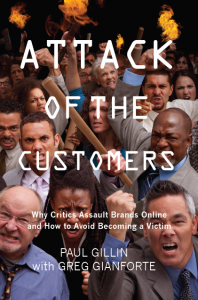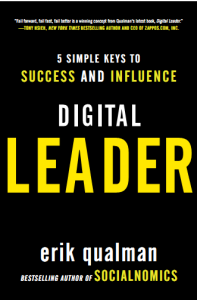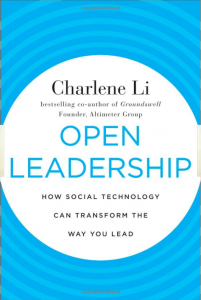TI don’t go to the South by Southwest conference for the sessions as much as for the people. The most interesting conversations usually happen outside of the conference rooms. One discussion that stuck with me this week occurred after a presentation by MIT’s Andrew McAfee entitled “What Does Corporate America Think of 2.0?”
While I was waiting in line to introduce myself to Mr. McAfee, I eavesdropped on a conversation he was having with the young woman in front of me. She gave her age as 28 and said she had recently been hired to coordinate social media at a real estate company where her bosses were mostly in their 50s. She was clearly demoralized and frustrated.
The young woman had been brought on board to get the realty company up to speed in the new Web technologies. She understood that conversational marketing requires a culture change, but her management wasn’t interested. Her bosses, she explained, saw social technology as simply another way to distribute the same information.
For example, she had been ordered to post press releases as blog entries and to use Twitter strictly for promotional messages. She had been told to get the company on Facebook but not to interact with anyone on its fan page.Her communications with the outside world were to be limited to platitudes approved by management.
I felt bad for this young lady and also for her bosses, who will no doubt lose her in short order. I suspect they hired a social media director in the belief that she could create new channels for them, but they didn’t understand the behavioral change that was required on their part.
Open Leadership
A couple of nights earlier, I attended a dinner given by Altimeter Group, whose founder, Charlene Li, co-authored the ground-breaking book Groundswell. Charlene was handing out galley copies of her forthcoming book called Open Leadership. In it, she suggests that management strategies must fundamentally change in the age of democratized information. I’ve only read a third of the book so far, but I can already tell that it will cause considerable discomfort in corporate board rooms.
In the opening chapter, Charlene notes that “to be open, you need to let go of the need to be in control… you need to develop the confidence… that when you let go of control, the people to whom you pass the power will act responsibly.” This notion of leadership replacing management will shake many of our institutions to the core.
The traditional role of management has been to control and communicate: Managers pass orders down from above to the rank-and-file who are expected to do what they are told.
In the future, communication will increasingly be enabled by technology. Employees will be empowered with information and given guidelines and authority to do the right thing. Middle managers won’t be needed nearly as much as they are today. Organizations will become flatter, more nimble and more responsive because information won’t have to pass up and down a chain of command before being acted upon. This will result in huge productivity gains, but progress will only be achieved when top executives learn to let go of the need to control and to accept the uncertainties of empowered constituents.
No Pain, No Gain
The real estate company’s mistake was in believing that it could participate in a new culture without changing its behavior. It saw social media as a no-lose proposition; distribute the same material through new channels but don’t accommodate the reality that constituents can now talk back. Any company that takes this approach will fail to realize the benefits of the media. Once its customers realize that their opinions don’t count, they will stop engaging with the company. That doesn’t mean they won’t do business with the company any more, but the benefits of using the new media will be lost.
I have never advocated that all companies adopt social media. Each business has a different culture, and some adapt more readily to open leadership than others. If employee empowerment and institutional humility don’t fit with your style, then social media is probably not for you. You may do just fine for several years without changing your practices. But if you choose to play in the freewheeling markets enabled by customer conversations, then you’d better be willing to let go of control.
Over time, I believe all companies will have to give up the belief that they can control their markets, because interconnected customers are an unstoppable force. In the short-term, however, businesses need to do what feels right for them. If you work for a company that can’t adapt itself to the concept of open leadership, then start circulating your resume. These days, there are plenty of businesses that are eager to change.;sr=1-12″> he Joy Of Geocaching, a labor of love that my wife Dana and I have been working on seemingly since the Reagan administration, arrived at the publisher’s warehouse this week. This project began in July, 2008 and proceeded through many twists and turns – including the demise of our first publisher – before reaching the finish line.
he Joy Of Geocaching, a labor of love that my wife Dana and I have been working on seemingly since the Reagan administration, arrived at the publisher’s warehouse this week. This project began in July, 2008 and proceeded through many twists and turns – including the demise of our first publisher – before reaching the finish line.
Publication of a book is a good time to reflect on what you’ve learned and I realize now how much I learned about social networking from this project.
If you’re not familiar with geocaching, it’s an outdoor game played by three to four million mostly adults worldwide. Players hunt for hidden containers using global positioning receivers. The geographic coordinates of the containers – which can range in size from the tip of a pencil eraser to, in one case, a Nissan Pathfinder – are published at Geocaching.com. The photo shows an example of a particularly clever container.
 All containers must contain a paper log, but nothing more is required. The joy of geocaching is in the hunt and the reward of finding a geocache is nothing more than satisfaction. Geocaching.com recorded its one millionth active geocache placement early this week.
All containers must contain a paper log, but nothing more is required. The joy of geocaching is in the hunt and the reward of finding a geocache is nothing more than satisfaction. Geocaching.com recorded its one millionth active geocache placement early this week.
Sounds simple and maybe a little weird, right? I certainly thought so at first. But as Dana and I began to geocache and then talk to people who love the game, we found that an enormous social network had developed around it. People were forming new relationships, repairing old ones, improving their health and re-connecting with nature in ways that would have been impossible without technology.
Passion for Cachin’
We met people who have logged more than 35,000 finds over the last eight years. One small circle of friends drove 12,000 miles – and flew another 10,000 – in a mad dash to find a geocache in all 50 states in 10 days. Another team spent weeks planning a speed run that netted a record 413 finds in 24 hours. Their record was broken just five months later.
We met an elite group of “extreme geocachers” who pursue containers hidden under water, on abandoned railroad trestles, deep in mine shafts and at the top of 100-foot sheer rock cliffs. Then there are the people who hide caches. Some of them spend days constructing elaborate themed networks consisting of dozens of containers. Others concoct puzzles so devious that we didn’t know where even to begin to solve them.
The social network that ties this community together is a quirky website run by a rather reclusive for-nonprofit organization in Seattle called Groundspeak. The Geocaching.com website is basically a database with a few HTML pages and some query forms. It has almost none of the trappings of Web 2.0, not even photo tags. The only means users have to create content is its rigidly formatted description pages and comment forms.
Human Ingenuity
Yet despite those limitations, the geocaching community has done some wonderfully inventive things. Geocaching has its own language. More than 100 clubs and associations have sprung up in all 50 states and overseas. Geocachers arrange community cleanups, stage fund-raising events and help each other in times of need. They created “event caches” long before the concept of the unconference caught on. And they’ve done this without any prompting from above, using a simple website built around a simple game.
Here are some lessons I’ve learned:
There Is No Substitute For Passion. Groundspeak does almost nothing to market the game. It provides an online meeting place, a newsletter and some basic services in exchange for a $30 annual fee. Geocaching has spread to an audience of more than three million players entirely by word of mouth. The one million records in its database have each been meticulously reviewed by a team of volunteers.
It’s Not About Technology. The Geocaching.com website is five years behind the technology curve. It has some rudimentary Web 2.0 features, but few members use them. The website really does only one thing well, but that’s all its users ask it to do. Too much technology would actually complicate the experience.
People Basically Want To Do The Right Thing. Every community has its petty rivalries, but in interviews with more than 60 enthusiasts and casual conversations with many more, we encountered only one case in which a dispute resulted in the destruction of personal property (a geocache). In contrast, we heard dozens of stories about geocachers putting their personal safety in the hands of total strangers simply because the person was another geocacher.
Peer Recognition Matters. One of Groundspeak’s early innovations was to keep a running tally on its website of each member’s total hides and finds. This is a source of a constant friendly rivalry among players. Top geocachers not only know their own tallies but also the totals of those nearest to them in the hierarchy.The drive to be visible is an incredible motivator.
Simple Succeeds. I noted in a column last year the irony that Twitter, with its stripped-down simplicity, has been a social media mega-hit while the technically elegant but byzantine Second Life has faded into a niche. In the same ways, geocaching succeeds because it keeps the rules simple. This has enabled players to develop an incredibly rich variety of variations, and Groundspeak has commendably remained open to letting them take the game where they wish.
There’s so much more I could say (224 pages worth, in fact!) about this remarkable community, and I’m hoping to develop a presentation around this topic for business audiences. It will include lots of funny, scary and touching stories that we learned in our research and show how online connections can contribute to more meaningful real-world relationships.
I need a sponsor, though, so if your company or group is in terested in bringing me in for an entertaining and instructive one-hour session on how an online network can drive millions of people into the woods to re connect with nature, please drop me a line.









